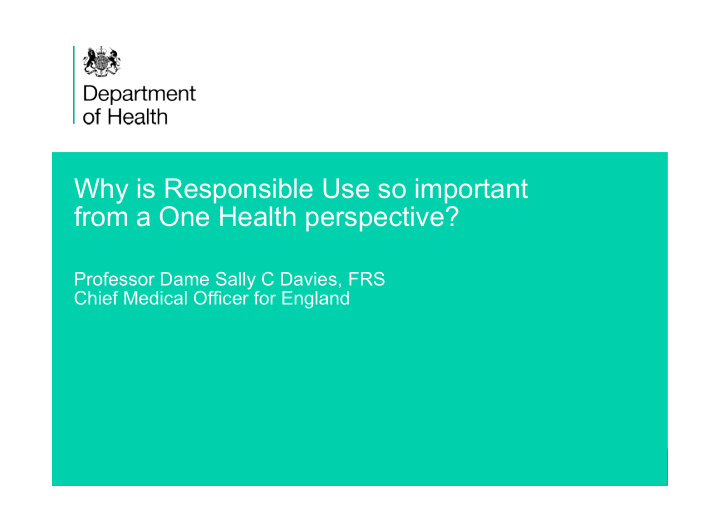



Why is Responsible Use so important from a One Health perspective? Professor Dame Sally C Davies, FRS Chief Medical Officer for England 1
It is not difficult to make microbes resistant to penicillin in the laboratory, and the same has occasionally happened in the body. Alexander Fleming, 1945 Nobel Prize Acceptance Speech 2
Seas & AQUACULTURE Swim lakes Epidemiology Drinking Irrigation of AMR water water Drinking Rivers & water streams Antibiotics Farm effluents & Soil Sewage manure spreading Vegetables, seed WILDLIFE crops, fruits & Dead Offal vegetables Rendering stock Industrial & household Animal antimicrobial Swine feeds chemicals Care Hospital facilities FOOD Cattle Sheep Commercial Antibiotics Handling, abattoirs & Meat & HUMANS ANIMALS preparation, processing fish consumption plants Urban Rural Poultry Others areas areas COMPANION Food processing ANIMALS antimicrobials Direct contact 3 Diagram based on Linton (1977), as adapted by Rebecca Irwin, Health Canada (Prescott 2000) and IFT
Years of Discovery of New Classes of Antibiotics Discovery void 1953 1961 No new class of antibiotics has been discovered 1978 1946 1947 1952 1955 1962 1976 for 26 years 1928 1932 1957 1943 1945 1948 1950 1969 1971 1979 1987 1920s 1930s 1940s 1950s 1960s 1970s 1980s 1990s 2000s 2010s 4
Global Antibiotic Consumption in Livestock 5
Crossing the Human/Animal Border JOINT INTERAGENCY ANTIMICROBIAL CONSUMPTION AND RESISTANCE ANALYSIS Antimicrobial Antimicrobial consumption in consumption in humans animals Antimicrobial Antimicrobial resistance in resistance in humans animals Positive associations for consumption of fluoroquinolones in food- producing animals and occurrence of resistance in E. coli from humans Positive associations for consumption of macrolides in food- producing animals and occurrence of resistance in C a mpylobacter spp. from humans. Positive associations for consumption of tetracyclines in food- producing animals and occurrence of resistance in Salmonella spp. and Campylobacter spp. in humans. Source: ECDC/EFSA/EMA first joint report on the integrated analysis of the consumption of antimicrobial agents and 6 6 occurrence of antimicrobial resistance in bacteria from humans and food-producing animals
Challenges • Sanitation and hygiene • Clinician knowledge + Patient/public demand • Scientific – drugs, vaccines, diagnostics, surveillance • Economic – pipeline, business models in animal husbandry and agriculture • Geographical – access vs excess, global spread 7
International Action • Successes so far: • WHO, FAO and OIE resolutions, 2015 • Global Health Security Agenda – AMR action package • Increasing International support at the highest levels • UK Fleming Fund • Independent AMR Review • Diagnostic Prizes • Looking ahead: • Implementing the GAP • WEF • G20 • G7 • UNGA 8
Recommend
More recommend